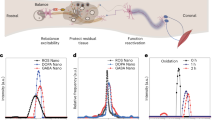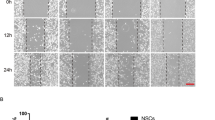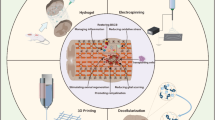Abstract
Spinal cord injury results in immediate disruption of neuronal membranes, followed by extensive secondary neurodegenerative processes. A key approach for repairing injured spinal cord is to seal the damaged membranes at an early stage. Here, we show that axonal membranes injured by compression can be effectively repaired using self-assembled monomethoxy poly(ethylene glycol)-poly(d,l-lactic acid) di-block copolymer micelles. Injured spinal tissue incubated with micelles (60 nm diameter) showed rapid restoration of compound action potential and reduced calcium influx into axons for micelle concentrations much lower than the concentrations of polyethylene glycol, a known sealing agent for early-stage spinal cord injury. Intravenously injected micelles effectively recovered locomotor function and reduced the volume and inflammatory response of the lesion in injured rats, without any adverse effects. Our results show that copolymer micelles can interrupt the spread of primary spinal cord injury damage with minimal toxicity.
This is a preview of subscription content, access via your institution
Access options
Subscribe to this journal
Receive 12 print issues and online access
$259.00 per year
only $21.58 per issue
Buy this article
- Purchase on Springer Link
- Instant access to full article PDF
Prices may be subject to local taxes which are calculated during checkout






Similar content being viewed by others
References
Thuret, S., Moon, L. D. F. & Gage, F. H. Therapeutic interventions after spinal cord injury. Nature Rev. Neurosci. 7, 628–643 (2006).
Bradbury, E. J. & McMahon, S. B. Opinion—spinal cord repair strategies: why do they work? Nature Rev. Neurosci. 7, 644–653 (2006).
Young, W. Role of calcium in central-nervous-system injuries. J. Neurotrauma 9, S9–S25 (1992).
Klussmann, S. & Martin-Villalba, A. Molecular targets in spinal cord injury. J. Mol. Med. 83, 657–671 (2005).
Baptiste, D. C. & Fehlings, M. G. Pharmacological approaches to repair the injured spinal cord. J. Neurotrauma 23, 318–334 (2006).
Krause, T. L. & Bittner, G. D. Rapid morphological fusion of severed myelinated axons by polyethylene-glycol. Proc. Natl Acad. Sci. USA 87, 1471–1475 (1990).
Lee, R. C., River, L. P., Pan, F. S., Ji, L. & Wollmann, R. L. Surfactant-induced sealing of electropermeabilized skeletal-muscle membranes in vivo. Proc. Natl Acad. Sci. USA 89, 4524–4528 (1992).
Shi, R., Borgens, R. B. & Blight, A. R. Functional reconnection of severed mammalian spinal cord axons with polyethylene glycol. J. Neurotrauma 16, 727–738 (1999).
Borgens, R. B. & Shi, R. Immediate recovery from spinal cord injury through molecular repair of nerve membranes with polyethylene glycol. FASEB J. 14, 27–35 (2000).
Borgens, R. B. & Bohnert, D. Rapid recovery from spinal cord injury after subcutaneously administered polyethylene glycol. J. Neurosci. Res. 66, 1179–1186 (2001).
Laverty, P. H. et al. A preliminary study of intravenous surfactants in paraplegic dogs: polymer therapy in canine clinical SCI. J. Neurotrauma 21, 1767–1777 (2004).
Borgens, R. B., Bohnert, D., Duerstock, B., Spomar, D. & Lee, R. C. Subcutaneous tri-block copolymer produces recovery from spinal cord injury. J. Neurosci. Res. 76, 141–154 (2004).
Cho, Y., Shi, R., Borgens, R. & Ivanisevic, A. Repairing the damaged spinal cord and brain with nanomedicine. Small 4, 1676–1681 (2008).
Luo, J., Borgens, R. & Shi, R. Polyethylene glycol immediately repairs neuronal membranes and inhibits free radical production after acute spinal cord injury. J. Neurochem. 83, 471–480 (2002).
Luo, J., Borgens, R. & Shi, R. Polyethylene glycol improves function and reduces oxidative stress in synaptosomal preparations following spinal cord injury. J. Neurotrauma 21, 994–1007 (2004).
Ditor, D. S. et al. Effects of polyethylene glycol and magnesium sulfate administration on clinically relevant neurological outcomes after spinal cord injury in the rat. J. Neurosci. Res. 85, 1458–1467 (2007).
Liu, J. B., Zeng, F. Q. & Allen, C. In vivo fate of unimers and micelles of a poly(ethylene glycol)-block-poly(caprolactone) copolymer in mice following intravenous administration. Eur. J. Pharm. Biopharm. 65, 309–319 (2007).
Burt, H. M., Zhang, X., Toleikis, P., Embree, L. & Hunter, W. L. Development of copolymers of poly(d,l-lactide) and methoxypolyethylene glycol as micellar carriers of paclitaxel. Colloids Surf. B Biointerfaces 16, 161–171 (1999).
Gref, R. et al. Biodegradable long-circulating polymeric nanospheres. Science 263, 1600–1603 (1994).
Duncan, R. The dawning era of polymer therapeutics. Nature Rev. Drug Discov. 2, 347–360 (2003).
Lentz, B. R. Polymer-induced membrane-fusion—potential mechanism and relation to cell-fusion events. Chem. Phys. Lipids 73, 91–106 (1994).
Wang, H. F., Fu, Y., Zickmund, P., Shi, R. & Cheng, J. X. Coherent anti-stokes Raman scattering imaging of axonal myelin in live spinal tissues. Biophys. J. 89, 581–591 (2005).
Basso, D. M., Beattie, M. S. & Bresnahan, J. C. A sensitive and reliable locomotor rating-scale for open-field testing in rats. J. Neurotrauma 12, 1–21 (1995).
Letchford, K. & Burt, H. A review of the formation and classification of amphiphilic block copolymer nanoparticulate structures: micelles, nanospheres, nanocapsules and polymersomes. Eur. J. Pharm. Biopharm. 65, 259–269 (2007).
Chen, H. et al. Fast release of lipophilic agents from circulating PEG–PDLLA micelles revealed by in vivo Forster resonance energy transfer imaging. Langmuir 24, 5213–5217 (2008).
Savic, R., Azzam, T., Eisenberg, A. & Maysinger, D. Assessment of the integrity of poly(caprolactone)-b-poly(ethylene oxide) micelles under biological conditions: a fluorogenic-based approach. Langmuir 22, 3570–3578 (2006).
Liggins, R. T. & Burt, H. M. Polyether–polyester diblock copolymers for the preparation of paclitaxel loaded polymeric micelle formulations. Adv. Drug Deliv. Rev. 54, 191–202 (2002).
Hausmann, O. N., Fouad, K., Wallimann, T. & Schwab, M. E. Protective effects of oral creatine supplementation on spinal cord injury in rats. Spinal Cord 40, 449–456 (2002).
Chvatal, S. A., Kim, Y. T., Bratt-Leal, A. M., Lee, H. J. & Bellamkonda, R. V. Spatial distribution and acute anti-inflammatory effects of methylprednisolone after sustained local delivery to the contused spinal cord. Biomaterials 29, 1967–1975 (2008).
Acknowledgements
The authors cordially thank W. S. Shim for preparation of mPEG–PDLLA di-block copolymers, G. Leung for isolation of spinal cord white matter strips from guinea pigs, J. Li for fabrication of the CAP recording chamber, K. Cheng and H. Lou for help in immunostaining and image analysis, Y. Zhang for histological examination and intracerebroventricular injection of dextran–FITC, X.-M. Xu and X. Wang for instructions on immunostaining, D. Bohnert for training of survival surgery, and C. Dowell, M. Bible, G. Brock and A. Peterson for help in blood draw. The work was supported by a Showalter Trust grant from Purdue University, an Indiana Spinal Cord and Brain Injury Research Fund from the State of Indiana, and partially supported by a fund from State of Indiana (HB 1444) to R.B.B. and R01 EB7243 to J.X.C.
Author information
Authors and Affiliations
Contributions
J.X.C., R.S., R.B.B. and K.P. equally contributed to the concept, experimental design, materials, equipment and conduct of the study. Y.S., S.K. and T.B.H. performed the experiments. Y.S. analyzed the data. Y.S. and J.X.C. co-wrote the paper. All authors discussed the results and commented on the manuscript.
Corresponding author
Supplementary information
Supplementary information
Supplementary information (PDF 2632 kb)
Rights and permissions
About this article
Cite this article
Shi, Y., Kim, S., Huff, T. et al. Effective repair of traumatically injured spinal cord by nanoscale block copolymer micelles. Nature Nanotech 5, 80–87 (2010). https://doi.org/10.1038/nnano.2009.303
Received:
Accepted:
Published:
Issue Date:
DOI: https://doi.org/10.1038/nnano.2009.303
This article is cited by
-
CD44-targeting hyaluronic acid-selenium nanoparticles boost functional recovery following spinal cord injury
Journal of Nanobiotechnology (2024)
-
Controlled delivery of a neurotransmitter–agonist conjugate for functional recovery after severe spinal cord injury
Nature Nanotechnology (2023)
-
Utilizing novel TBI-on-a-chip device to link physical impacts to neurodegeneration and decipher primary and secondary injury mechanisms
Scientific Reports (2022)
-
LncRNA CASC9 attenuates lactate dehydrogenase-mediated oxidative stress and inflammation in spinal cord injury via sponging miR-383-5p
Inflammation (2021)
-
NEP1-40-modified human serum albumin nanoparticles enhance the therapeutic effect of methylprednisolone against spinal cord injury
Journal of Nanobiotechnology (2019)



